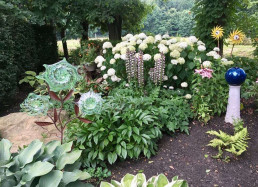Mulching Perennials
Most plants, including perennials, benefit from having mulch around their roots year-round. Organic mulch like shredded bark or hardwood makes our gardens look more polished, but it also serves several useful purposes including:
- Shading the plants’ roots and keeping the soil cooler, which makes the roots healthier
- Retaining soil moisture longer
- Preventing weeds from growing up into the plants
- Adding nutrients to the soil as the mulch disintegrates over time
Inorganic mulches like small stones or gravel can also be used, but they will not have the added benefit of enriching the soil since they do not break down. Stone can be useful in very windy locations where lighter mulch tends to blow away and is sometimes used on steep slopes where lighter mulch would wash away. Just beware that if you ever decide to switch from stone to organic mulch, it is back breaking work to remove those stones.
Whichever type of mulch you use, it is important to prevent it from touching the crown (base) of the plant. Spread your mulch carefully so that is lays nicely under your plant’s foliage but away from the crown. When mulch touches the crown, it is an invitation for plant rot and pest issues.
If you plant any perennials or shrubs in the fall, be sure to lay a 3-4 inch layer of mulch around them to prevent frost heaving during the winter months. The mulch will moderate the soil temperature so it remains consistent throughout the winter.
Perennial gardens benefit greatly from having a layer of shredded leaves placed over them in late fall or early winter after the plants have gone dormant. When you are raking earlier in the fall, shred and bag some of our leaved to use for this purpose. By spring, the shredded leaves in your garden beds will have mostly broken down and their nutrients will enrich the soil — it’s free fertilizer!
Original article written by Susan Martin and published by Proven Winners.
